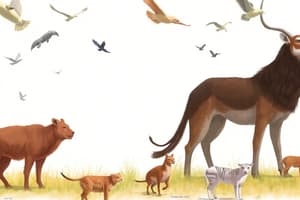Podcast
Questions and Answers
জীৱবিজ্ঞানৰ কোন শাখা জন্তুসমূহৰ অধ্যয়ন কৰে?
জীৱবিজ্ঞানৰ কোন শাখা জন্তুসমূহৰ অধ্যয়ন কৰে?
- নৱীন বিজ্ঞান
- জগুলি বিজ্ঞান
- জলজ বিজ্ঞান
- জীৱবিজ্ঞান (correct)
কোনো জন্তুৰ পৰিচয় কৰোৱাবলৈ দিখোটোমাছ কিজৰ ব্যৱহাৰ কৰা হয়?
কোনো জন্তুৰ পৰিচয় কৰোৱাবলৈ দিখোটোমাছ কিজৰ ব্যৱহাৰ কৰা হয়?
- বৰ্ণনা কাৰ্য
- দিখোটোমাছ চাবি (correct)
- ভিতৰ-ভিতৰৰ সমীকৰণ
- গৱেষণামূলক পদ্ধতি
কোন ভাগৰ অন্তৰ্গত আছেগৈ চাৰা কিচু উদাহৰণ?
কোন ভাগৰ অন্তৰ্গত আছেগৈ চাৰা কিচু উদাহৰণ?
- Mollusca, Echinodermata, Fungi
- Porifera, Cnidaria, Mammalia
- Porifera, Cnidaria, Chordata (correct)
- Chordata, Arthropoda, Annelida (correct)
প্ৰাণীৰদেৱ শারীৰিক আৰু ৰাসায়নিক প্ৰক্ৰিয়া কিহৰ অধ্যয়ন কৰে?
প্ৰাণীৰদেৱ শারীৰিক আৰু ৰাসায়নিক প্ৰক্ৰিয়া কিহৰ অধ্যয়ন কৰে?
অভ্যাস, শিক্ষণ আৰু সামাজিক আন্তঃকৰ্মৰ অনুৰোধৰ অধ্যয়ন কিহৰ অন্তৰ্গত?
অভ্যাস, শিক্ষণ আৰু সামাজিক আন্তঃকৰ্মৰ অনুৰোধৰ অধ্যয়ন কিহৰ অন্তৰ্গত?
জীৱ-জন্তুৰ পৰিৱেশৰ লগত যোগাযোগৰ পৰা কোন নিৰ্ধাৰণ হয়?
জীৱ-জন্তুৰ পৰিৱেশৰ লগত যোগাযোগৰ পৰা কোন নিৰ্ধাৰণ হয়?
কোন প্ৰতিষ্ঠিত আৰু সুৰক্ষা বিষয়ৰ মহত্বৰ অৰ্থ কেনে?
কোন প্ৰতিষ্ঠিত আৰু সুৰক্ষা বিষয়ৰ মহত্বৰ অৰ্থ কেনে?
কোন পদ্ধতিৰ দ্বাৰা সুৰক্ষা হুমলৈ মৰ্চাৰ ৰূপায়ণ কৰা হয়?
কোন পদ্ধতিৰ দ্বাৰা সুৰক্ষা হুমলৈ মৰ্চাৰ ৰূপায়ণ কৰা হয়?
Flashcards
জীৱ-বিজ্ঞানৰ শাখা
জীৱ-বিজ্ঞানৰ শাখা
প্ৰাণীসকলৰ অধ্যয়নৰ শাখা
প্ৰাণীৰ শ্ৰেণীবিন্যাস
প্ৰাণীৰ শ্ৰেণীবিন্যাস
সাধাৰণ বৈশিষ্ট্যৰ আধাৰত প্ৰাণীসকলক বিভিন্ন গোটত ভাগ কৰা ক্ৰম
প্ৰাণীৰ শাৰীৰিক কাৰ্য
প্ৰাণীৰ শাৰীৰিক কাৰ্য
প্ৰাণীৰ দেহৰ ভিতৰত হোৱা শাৰীৰিক আৰু ৰাসায়নিক প্ৰক্ৰিয়াৰ অধ্যয়ন
প্ৰাণীৰ আচৰণ
প্ৰাণীৰ আচৰণ
Signup and view all the flashcards
পৰিৱেশতাত্ত্বিক জীৱ-বিজ্ঞান
পৰিৱেশতাত্ত্বিক জীৱ-বিজ্ঞান
Signup and view all the flashcards
সংৰক্ষণ জীৱবিদ্যা
সংৰক্ষণ জীৱবিদ্যা
Signup and view all the flashcards
প্ৰাণীৰ বিভিন্নতা
প্ৰাণীৰ বিভিন্নতা
Signup and view all the flashcards
কশেরুকী
কশেরুকী
Signup and view all the flashcards
Study Notes
Introduction to Zoology
- Zoology is the branch of biology that studies animals.
- It encompasses a vast array of topics, from animal behavior and physiology to evolutionary relationships and ecology.
- Zoos, aquariums, and wildlife reserves often employ zoologists.
- The study of animals is crucial for understanding biodiversity and conservation efforts.
Animal Classification
- Animals are classified into various groups based on shared characteristics.
- The classification system primarily uses taxonomy, focusing on evolutionary relationships.
- Hierarchical structure: Kingdom, Phylum, Class, Order, Family, Genus, Species (King Philip Came Over For Good Soup).
- Dichotomous keys are used in identifying unknown organisms.
Animal Diversity
- Animals exhibit incredible diversity in their forms, functions, and behaviors.
- This diversity reflects adaptations to various environments and ecological niches.
- Examples of diverse animal phyla include: Porifera (sponges), Cnidaria (jellyfish, corals), Platyhelminthes (flatworms), Annelida (segmented worms), Mollusca (snails, clams, octopuses), Arthropoda (insects, crustaceans, spiders), Echinodermata (sea stars, sea urchins), and Chordata (vertebrates).
- Vertebrates are a subgroup of Chordata, characterized by a backbone and internal skeleton.
Animal Physiology
- Animal physiology examines the physical and chemical processes within an animal’s body.
- This includes functions: respiration, digestion, circulation, excretion, and nervous systems.
- These processes underpin the animal's survival and interaction with its environment.
Animal Behavior
- Animal behavior, or ethology, studies how animals interact with their environment and each other.
- Factors like instinct, learning, and social interactions are considered.
- Communication methods, predator-prey interactions, mating rituals, and parental care are components of animal behavior.
Animal Ecology
- The study of animal interactions within their environment and with other species.
- Factors influencing animal populations and communities are considered: habitat, food availability, predation, competition, and disease.
- Ecological principles are crucial for understanding and conserving biodiversity.
Conservation Biology
- This field applies ecological and evolutionary principles to address conservation challenges.
- Strategies for maintaining animal populations and protecting habitats are employed for species at risk.
Animal Evolution
- Animal evolution investigates the origins and diversification of animal life.
- Phylogenies reveal the evolutionary relationships between different animal groups.
- Evidence supporting evolution, including fossil records and molecular data, is used in the study.
Techniques in Zoology
- Microscopes and various laboratory techniques help in studying animal tissues and cells.
- Field observations provide insights into animal behavior and ecology.
- Molecular techniques (e.g., DNA sequencing) are crucial for understanding evolutionary relationships.
Studying That Suits You
Use AI to generate personalized quizzes and flashcards to suit your learning preferences.




